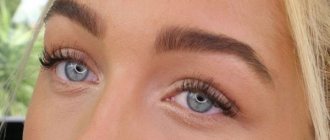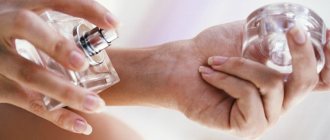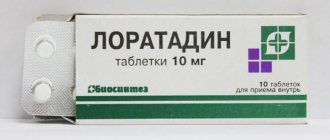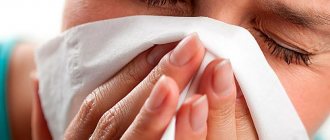Is there an allergy to eyebrow dye?
Eyebrow dye is produced using the same technologies as hair dye.
The dye must be mixed with an oxidizing agent (hydrogen peroxide). It causes the dye molecules to polymerize (or bond together) to create an intense shade. People with sensitive skin have an allergic reaction to oxidizing dyes, sometimes due to improper use of the dye. The presence of potentially irritating substances in eyebrow dye increases the likelihood of allergy symptoms.
ATTENTION! A pH level of 5.5 at the surface of the skin maintains a protective barrier, but when this is compromised, the penetration of allergens leads to an inflammatory response with the release of a number of cytokines. Thus, products that change skin pH favor the development of allergies.
Causes
It is important to know that all the components in the eyebrow dye are synthetic substances with an alkaline pH, created in the laboratory. Each has its pros and cons, it is impossible to say which is better or worse than the other.
The cause of the allergic reaction is skin hypersensitivity and toxicity of any of the components:
- paraphenylenediamine and paratoluenediamine;
- resorcinol;
- isatin;
- ammonia derivatives (for example, monoethanolamine);
- 6-Hydroxyindole;
- preservatives (parabens, formaldehyde);
- heavy metals (copper, nickel and cobalt);
- silicones;
- artificial flavors.
Moreover, they may cause cross-reactivity with chemical compounds in other products, medications, lotions or creams, including azo dyes, benzocaine, para-aminobenzoic acid.
Dye composition
Dyes use compounds of different chemicals and, thus, virtually any type of eyebrow dye is a potentially allergenic product. Each person may react differently to them and the consumer, especially those with allergies, should be aware of their problems.
- Ammonia, monoethanolamine, aminomethylpropanol: alkalizing agents that discolor and allow pigment to be introduced.
- p-Aminophenol, p-phenylenediamine, 1-naphthol, 4-amino-2-hydroxytoluene: dye precursors that impart color.
- Hydrogen peroxide: an oxidizer and decolorizer.
- Water, propylene glycol, ethanol and glycerin: solvents, dye vehicles.
- Sodium lauryl sulfate, diethanolamide, oleylpolyoxyethylene: surfactants (foaming agents and thickeners).
- Disodium phosphate, citric acid: stabilizing regulators.
- Glyceryl stearate and cetearyl alcohol: fatty alcohols and emollients.
- Polyquaternium and cetrimonium chloride: conditioners.
Many people prefer to use natural products such as henna to avoid adverse reactions, although without the use of chemical compounds in the composition, the effect of coloring on the eyebrows does not last for a long time.
Chronic pathologies
Allergic dermatitis is the most difficult manifestation of an allergic reaction, given that it is a lifelong problem that has no cure and can lead to active sensitivity to products containing, for example, the allergen paraphenylenediamine.
Incorrect application
While tinting your eyebrows is not a difficult task, it is important to remember that any chemical near the eye area can be extremely dangerous. To minimize the risk of irritation and dye getting into the eyes, you can use some kind of blocking solution: apply petroleum jelly or olive oil to the forehead and area around the eyes.
Live healthy! Dangers in a hair salon. (09/22/2016)
Failure to comply with the storage period
An unopened tube of eyebrow tint usually has a shelf life of three years. Although some brands claim that their product has an unlimited shelf life, this seems incredible and it is not worth experimenting to see if this is true.
For professional products, the shelf life expires 1-2 years after opening the paint; popular paints are stored for much less time. The first clue that the product is unsuitable for use may be a change in color and an unpleasant odor after opening the tube. The dye may appear cloudy or separate.
Side effects of expired eyebrow dye:
- the chemical composition and method of reacting with hairs changes;
- the color is not intense or pigmented; expired dye tends to wash off quickly;
- risk of an allergic reaction.
What to do if you have an allergic reaction to henna
An allergy to henna for eyebrows requires immediate treatment; if you do not pay attention to the warning symptoms, there is a possibility of causing serious harm to a person’s health.
Despite the fact that lavsonia leaves are a natural product, they can provoke the development of allergic reactions, especially in sensitive people.
How such an allergy develops, what can be done to quickly relieve acute symptoms, and how to prevent the development of the problem, we will consider below.
Causes of allergies to henna for eyebrows
Henna is a powder that is obtained by grinding the leaves of a shrub called Lawsonia. Allergic reactions rarely occur in response to the use of this powder.
However, the likelihood of their occurrence increases many times when unscrupulous manufacturers add chemical components to the composition of the substance. Black henna, which actually does not exist in nature, is considered especially dangerous.
It is dangerous due to paraphenylenediamine, the presence of which gives a dangerous cumulative effect, leading to the development of leukemia, cancer, and bronchial asthma.
Natural henna can only have brown or red shades; all other colors indicate the presence of additional chemical components that are potentially hazardous to human health.
Reasons for developing an allergy to henna:
- the use of a low-quality product containing synthetic additives;
- growth of shrubs in unfavorable environmental conditions;
- a person’s predisposition to allergic reactions at the genetic level;
- weak immunity, the presence of chronic diseases.
A factor that deserves special attention is the high sensitivity of the skin to various substances.
Thin skin, tiny cracks, dryness - all these are provocateurs that cause dangerous symptoms.
Allergies develop especially often when henna is used to color eyebrows, because here the skin is especially thin and sensitive and reacts faster to irritation.
Symptoms of allergy to henna for eyebrows
You can conclude that an allergic type reaction has occurred based on the characteristic symptoms:
- nasal discharge;
- sneezing;
- persistent itching in the eye area;
- redness of the mucous membrane of the organs of vision;
- lacrimation;
- difficulty breathing;
- cough;
- difficulty inhaling and exhaling when moving;
- dermatitis;
- peeling of the skin;
- swelling of tissues;
- a burning sensation developing at the site of application of the composition;
- Quincke's edema, anaphylactic shock.
Before using a product containing henna, it is necessary to conduct a preliminary test to assess the skin's reaction by applying a small amount of the product to the crook of the elbow. If any disturbing symptoms appear, you will have to stop using the product.
Can the constant use of henna, with increased reactions from the skin, cause long-term health problems? Perhaps, according to experts, if a person does not receive the necessary anti-allergy therapy, he may experience much more dangerous symptoms. These include deterioration of the gastrointestinal tract, the development of eczema, and other disturbances in the normal functioning of the body.
In rare cases, lichen may appear and angioedema may develop, which can cause anaphylaxis and death. To prevent the development of such consequences, it is necessary to stop contact with the pathogen as soon as negative reactions of the body appear.
Diagnostics
A key step in the diagnostic process is taking an anamnesis. The specialist conducts a visual examination of the patient, makes a diagnosis in order to prescribe adequate therapy.
When there is no exact information about the cause of the appearance of unpleasant symptoms, the allergist can give the patient a referral to take an analysis for the level of immunoglobulin E in the blood, or take skin tests.
Blood analysis
Taking a general blood test will help determine the presence or absence of an allergic reaction in the body. This is necessary to exclude other pathological causes of disruption of the body.
When the number of lymphocytes and immunoglobulin E is higher than normal, there is a possibility of allergies.
Skin tests
To determine the specific substance that provoked the occurrence of a pathological reaction, you need to take skin allergy tests. This procedure is not complicated; the allergen is introduced into the forearm using microscratches or injections. Afterwards, all that remains is to observe the local reaction of the skin.
During one procedure, the patient can be administered up to 15 samples for various pathogens, which are selected by studying the patient’s medical history.
The presence of a reaction to the pathogen is indicated by the occurrence of itching, swelling, and redness in the place where the samples were taken.
Carrying out skin tests using a scarifier is unacceptable if a strong reaction to henna is suspected; such manipulations can cause anaphylactic shock.
First aid
If a person has an allergic reaction, what to do? Every cosmetologist who carries out procedures for coloring hair, nails, and eyelashes must become familiar with the peculiarities of providing first aid in such situations.
When, during coloring, a local allergic reaction develops, you must immediately remove the coloring composition from the surface of the skin. It is also important to take an antihistamine. If these measures are not enough, you should seek help from a doctor who will prescribe effective treatment.
Treatment
The use of drugs that have an antibacterial effect during the treatment of allergies is inappropriate. Here it is more important to take medications that eliminate the local reaction.
The specific types of medications that the doctor will prescribe will depend on how severe the symptoms were and how exactly the lawsonia powder was used.
Antihistamine
Suprastin, Tavegil are common drugs, the use of which can reduce the severity of negative reactions of the body and reduce the probable risks of complications.
Antihistamines can be used in the form of tablets, creams, and ointments.
If there is a serious risk of developing a severe allergic reaction, the doctor may prescribe drugs containing hormones - Hydrocortisone, Prednisolone.
Elimination
The elimination type of treatment consists in completely eliminating subsequent human contacts with the allergen that caused the negative reaction.
This means that the powder cannot be used to dye hair on the head, eyebrows, or apply tattoos.
When such measures bring relief, the reactions no longer appear, we can conclude that henna was the cause of the deterioration of the person’s condition.
After some time, you can try using a small amount of product from another manufacturer. The main thing is that it contains only lawsonia powder and does not have any extraneous chemical additives.
You can try the next type of henna no earlier than a week has passed since the first unsuccessful attempt.
other methods
If a woman has chosen to dye her eyebrows with henna, but suffers from an allergic reaction, there are some ways she can try to cope.
- If dermatitis develops, you can use hormonal ointments Elcom, Advantan or a non-hormonal type - Videstim.
- To disinfect the skin surface and prevent the addition of a bacterial infection, Levomekol and Fucidin are used.
- In some cases, with a severe allergic reaction, body temperature may increase slightly. In this case, you can take Ibuprofen, Paracetamol.
- To quickly remove reactions from the skin and remove toxins from the body, you need to drink enterosorbents, for example, Enterosgel, activated or white carbon.
- Throughout the acute period, you need to drink plenty of fluids and follow a hypoallergenic diet. This will facilitate the rapid removal of toxins from the body and the disappearance of unpleasant symptoms.
- If a person often suffers from allergic reactions, he can use shampoos from Vichy, Nizoral to remove henna from hair and eyebrows.
Folk
Eyebrows dyed with henna and subsequently causing a negative reaction can also be treated using traditional methods.
- Lotions from decoctions of medicinal herbs (sage, oak bark, chamomile, calendula). First you need to pour a tablespoon of dry leaves with a glass of boiled water and leave for 30 minutes. Soak cotton pads in the infusion and make lotions that are kept on the damaged skin for up to 20 minutes.
- To reduce itching and reduce the volume of rashes, you need to prepare a solution of boric acid. To do this, a teaspoon of dry substance is diluted in 200 ml of water. Gauze folded in several layers is moistened in the solution and applied to the affected areas for 15 minutes.
- To reduce swelling, use a decoction of flax seeds. To prepare a healing mixture, you need to pour a tablespoon of seeds into 100 ml of boiling water, after infusing for half an hour, shake and moisten the gauze in the composition. You need to keep this compress for up to 20 minutes.
- Residual reactions can be removed from the face using kefir and yogurt compresses.
Prevention of allergies to henna for eyebrows
To prevent eyebrow burns with henna, you need to adhere to the following preventive measures:
- carry out the coloring procedure only in a beauty salon by professionals;
- before applying henna to the brow line, it is necessary to conduct preliminary testing for the likelihood of developing an allergic reaction;
- It is prohibited to perform treatment on eyebrows with acne or open skin lesions;
- for home coloring, purchase paint in specialized professional cosmetics stores, pharmacy chains, and beauty salons;
- It is forbidden to mix different types of henna for one coloring; you must use only one type of powder;
- use only completely natural products that do not contain chemical components for coloring the eyebrows and hair;
- work with henna only with protective gloves;
- be sure to check the expiration date of the powder before diluting it, do not use henna that has already expired;
- store the purchased product in compliance with the storage conditions and terms.
An allergic reaction that occurs from the use of henna is not uncommon. Most often, this situation arises due to violation of coloring rules, as well as the presence of additional chemical components in the powder. When the first negative symptoms appear, it is necessary to immediately remove the composition from the surface of the face and carry out the necessary therapeutic measures.
Source: //borodadeda.ru/uchod-strizhka-britie/allergiya-na-hnu-dlya-brovej-lechenie/
How does the reaction manifest itself?
The allergy affects the skin of the forehead, eyelids, possibly ears and neck, manifesting itself as contact dermatitis or inflamed skin.
A common symptom is swelling, given that the paint comes into contact with the face. It is extremely dangerous if chemicals (in particular three percent hydrogen peroxide) touch the delicate cornea in the eye. There is a serious risk of contracting conjunctivitis. Eyelash after eyelash may fall out. Symptoms may appear within 2-3 days, and last several days or weeks depending on the severity of the allergic reaction. The intensity of symptoms depends on the concentration and time of exposure to the product.
Local symptoms
Signs representing an allergic reaction to eyebrow dye, burning and itching may be accompanied by:
- erythema;
- dry skin;
- peeling or hives;
- tearfulness.
ALLERGY to paint \HOW TO FIGHT?
Respiratory manifestations
- Cough.
- Nasal congestion.
- Bronchial spasms.
How to identify an allergen?
To protect yourself from a possible henna allergy, you should get it checked. This can be done at home. To make sure the paint is safe, you need to apply it to the skin of your wrist and wait a while. 20 minutes will be enough. If even the slightest irritation appears in the area where the paint was applied, it is better to refuse such henna.
If an allergy occurs and it is necessary to identify which allergen caused such a reaction, you should contact an allergist. After a detailed analysis, the appropriate analysis will be prescribed. You can identify the allergen using:
- A skin test is a method of identifying an allergen in which possible allergens are injected into the skin of an allergic person through an injection in a small concentration.
- scratch test - a test in which small scratches are made on the skin, after which a probable allergen is applied to them.
With each of these two methods, a response is observed. It may manifest itself in the form of redness or swelling, in which case an allergy to this substance is confirmed.
A more accurate allergen detection test is to determine the presence of antibodies to the allergenic substance in the patient's blood. This analysis allows us to determine the stage of the allergic disease.
How to determine the possibility of a reaction
An allergic reaction is a medical problem and it is recommended that concerned consumers consult a dermatologist or eye specialist. A possible allergy test before tinting your eyebrows for the first time (or after a long break) should be carried out by a dermatologist in order to have reliable results.
Sensitivity test
The first way to find out if there is an allergy is a patch test, which is done 24 hours before the eyebrow tinting procedure. A small amount of paint is applied to an area of skin on the arm and left overnight. If an allergic reaction occurs (rash or hives), then it is better to refuse paint in favor of eyebrow shading with temporary makeup.
At an appointment with an allergist
Personal, family, professional history related to skin sensitivity, habits of using cosmetics - questions that interest an allergist before he can determine whether there is an allergy to eyebrow dye and what to do in this case. Physical examination can rule out signs of inflammation and the presence of other dermatitis (contact and atopic dermatitis).
Preventive actions
To prevent henna burns, you must follow simple rules:
- Eyebrow tinting should only be done in a beauty salon.
- Do not apply paint to injured skin. If you have wounds, scratches, acne, dermatitis, or neurodermatitis, you should avoid tinting your eyebrows or getting a tattoo.
- Before the procedure, it is recommended to conduct an allergy test: apply a small amount of the dye to the inner surface of the wrist and leave for 20 minutes. If itching or redness of the skin occurs, this paint should not be used.
- Rubber gloves should be worn during the henna dyeing procedure. Such actions will help prevent the development of allergies or chemical burns on your hands.
- You need to purchase henna only in pharmacies or specialized stores. This will help you avoid buying low-quality goods.
- You need to apply a tattoo with one pigment, without experimenting with mixing different colors.
You can cure henna burns quickly and without complications if you consult a doctor in a timely manner. If left untreated, a burn can lead to scars or other serious consequences.
Allergy treatment
Treatment of sensitive skin consists of several stages. In cases where there is a predisposing dermatitis to the symptoms, control of the disease helps to improve the condition. In addition, the use of any cosmetic products should be discontinued within two weeks. After this period, the products are re-used, introduced one at a time.
First aid
With skin sensitivity, it is normal to want to know how to treat it, what to do if a case of an allergic reaction is relevant. But first aid, if it appears, is, first of all, to wash off the paint as quickly as possible and thoroughly rinse the affected area. This will help reduce the worsening of symptoms.
Drug therapy
Allergy to eyebrow dye, treatment with medications:
- Moderate topical corticosteroids (for three to four days) and antihistamine tablets are used to relieve symptoms.
- Topical immunomodulators, for example, Hymecrolimus or Tacrolimus ointment, are used for a longer period.
Folk recipes
As an additional remedy, you can treat allergies to eyebrow dye with folk remedies. Rinse the affected areas with decoctions made from medicinal herbs (chamomile, string, calendula or sage).
WHAT IS IT BETTER TO DYE YOUR EYEBROWS, HENNA OR PAINT?
Treatment of a burn from henna
For severe allergies to henna, doctors prescribe antiallergic drugs:
- Suprastin. Take the drug 75-100 mg per day during meals, without chewing and with a sufficient amount of water.
- Zyrtec. The daily dosage of the medication is 5-10 mg per day (once).
- Zaditen. Tablets are taken with meals, 1 mg twice a day (morning and evening).
- Tavegil. Take the drug 1 mg in the morning and evening.
- Cetrin. Take 1 tablet per day.
In addition, ointments intended for external use are prescribed for the treatment of burns:
- Hydrocortisone. The medicine has anti-inflammatory, anti-edematous, antipruritic effects. The product is applied in a thin layer to the affected areas of the skin 2-3 times a day.
- Prednisolone helps suppress the skin inflammatory reaction and reduce increased vascular permeability at the site of inflammation. In addition, the medication reduces itching and pain at the site of application. The medicine should be applied in a thin layer to the affected areas of the skin 1 to 3 times a day.
If there are signs of infection in the affected area, it is necessary to treat the burn surface with antibacterial drugs, for example Levomekol, Levosin, Fucidin.
It is also recommended to treat chemical burns with wound-healing external agents. These include: Bepanten, Actovegin, Solcoseryl.
For allergies, it is advisable to use enterosorbents, which help remove toxic substances from the body. The drugs are taken for 7-10 days. The most effective of them are:
- Enterosgel.
- Polypephane.
- Activated carbon.
As an auxiliary therapy, doctors prescribe immunomodulatory drugs that help strengthen the immune system.
What to do for prevention?
For allergies, it is important not only to be treated, but also to take preventive measures. You will have to eliminate tattooing or chemical dyes in favor of natural, plant-based dyes. And even in this case, an allergy test should be done before application. Many manufacturers, claiming that the paint is “natural”, use other harmful substances in the resin composition.
IMPORTANT. Proper hydration of the skin, as part of therapy, helps restore and maintain its protective balance. Moisturizers are chosen with a small number of components in the composition, without alcohol-containing ingredients and, of course, substances that can irritate the skin (for example, urea).
Eating a healthy diet is another way to reduce the incidence of allergic reactions in general. Green leafy vegetables, carrot juice, and fruits help in treating a number of skin diseases.
Next Post
Previous Post
What you don’t know about henna tattoos and the consequences of its use
A beautiful tattoo, just like the one in the photo, always attracts attention. and fashionable. And how nice it is to know that a stylish accessory will disappear after some time and not a trace will remain in its place. But, unfortunately, the promises of the masters and the hopes of their clients do not always come true. Recently, cases of dermatological reactions have become more frequent.
Surprises they won't tell you about
In the photo with advertising billboards you can see what unusual, elegant patterns can be made on the body. This is a good bait for modern people and children who constantly want a holiday and bright decorations. But interesting entertainment with henna does not always end well for the experimenter.
In recent years, people with chemical burns after receiving a temporary tattoo have begun to often come to hospitals. Immediately after application, the picture does not indicate its danger in any way, but literally after a week or more, an allergy to henna develops, redness, swelling, blisters, small wounds, and itching are felt. Photos with such disastrous results flooded the Internet.
This is how an allergy to poorly executed mehendi develops. In oriental art, which came to us from distant ancient times, images were applied only with natural composition.
Henna was prepared from lavsonia leaves: collected, dried, and then ground into powder. Only from such natural material can a design that is safe for the skin be created.
Only a small number of people are found to be intolerant to this type of coloring composition.
But since it takes a long time to prepare a mass of lavsonia and one cannot deviate from the recipe, street artists and careless craftsmen in salons use mixtures with chemical additives in their work.
If your mehendi gave a negative reaction, then this is not an allergy to henna, it is a burn from aggressive substances in the paint.
Such drawings in the photo look bright and colorful, in contrast to natural paste, which gives a dark brown tint. Artificial pigments allow you to create images in black, red, green and other colors. This greatly attracts children and young people, but it is their skin that most often gives such negative reactions to contact with chemicals.
We recommend reading:
- Temporary tatoos
- Stencils for mehendi
Itchy eyebrows: what to do if they itch a lot, and how to find out the causes of this phenomenon
Useful tips on what to do if you are concerned about severe itching of the eyebrows: why they may itch, an overview of possible causes, identifying additional symptoms (where they itch, whether they are flaking, etc.), a list of home and medicinal antipruritic remedies (herbs, ointments, gels) , balms).
Under the influence of various factors, nerve endings in the skin can be irritated, causing unbearable itching. The causes can be both internal diseases and external circumstances. It is especially unpleasant when this happens to the face.
For example, severe itching of the eyebrow will lead to scratching, swelling, redness and even hair loss. They itch very much because they act as a protective barrier and absorb all the dust and dirt from the atmosphere, which increase skin irritation.
And if you add to this the constant growth of hairs, it becomes clear why this part of the face is most susceptible to this scourge. It's time to figure out why this happens and how to deal with it.

First aid
If a person has an allergic reaction, what to do? Every cosmetologist who carries out procedures for coloring hair, nails, and eyelashes must become familiar with the peculiarities of providing first aid in such situations.
When, during coloring, a local allergic reaction develops, you must immediately remove the coloring composition from the surface of the skin. It is also important to take an antihistamine. If these measures are not enough, you should seek help from a doctor who will prescribe effective treatment.
About the reasons
A few decades ago, henna was considered an absolutely hypoallergenic and safe dye, but today everything has changed. Such a natural plant began to cause allergies due to several factors:
- The use of chemical fertilizers when growing shrubs. Production technology prohibits this, but unscrupulous manufacturers often do not comply with the regulations and try to accelerate the growth of raw materials.
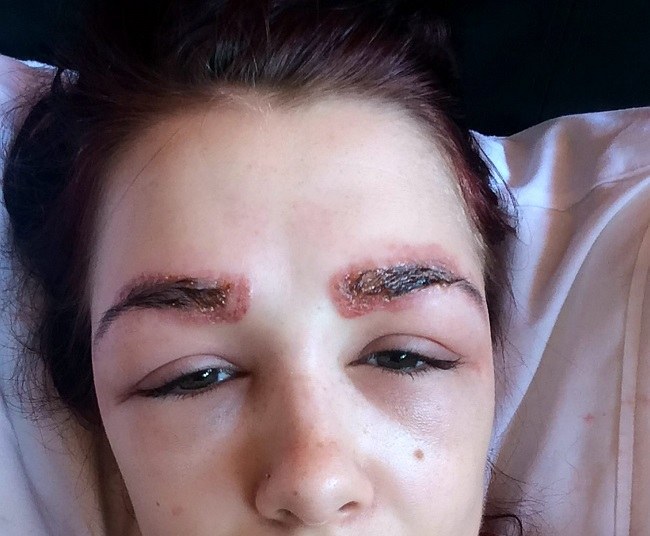
- Deterioration of the environmental situation in general. Air and soil pollution affects the quality of the plant.
- Reduced protective reactions of the body against the background of environmental changes. It is worth recognizing that the health of the population is deteriorating, which affects the functioning of the immune system.
- Introduction of additional ingredients into the paint composition. Manufacturers are trying to create a long-lasting, rich color, and this requires the addition of chemicals.
Symptoms of itchy eyebrows
Usually, itching of the skin of the eyebrows is not limited to just the desire to scratch this area. A lot of other unpleasant signs appear that not everything is in order with the body. This may include peeling, redness and hair loss. Each of the symptoms will help you determine the root cause.
In addition, dermatologists have a so-called “face map”, on which each point is responsible for the work of some internal organ. So try to observe where exactly your eyebrow itches and whether the itching is limited to just that area of your face.



